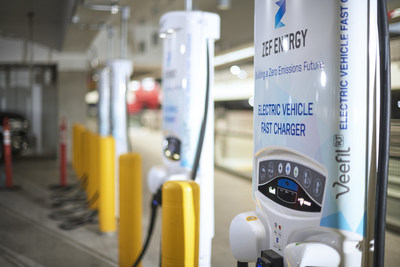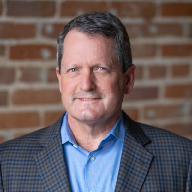 The electric vehicle (EV) revolution is rapidly transforming global mobility markets. The United States has implemented policies to help drive this momentum, offering federal subsidies of up to $7,500 for qualified EVs. As the economics of transportation continue to shift away from fossil fuels, companies are increasingly retiring their gas-powered fleets. Additionally, federal agencies are also making rapid strides toward light, medium, and heavy-duty vehicle electrification, and consumers are embracing change like never before. More than 4 in 10 Americans now say they’re looking to go electric — a dramatic increase from just a few years prior.
The electric vehicle (EV) revolution is rapidly transforming global mobility markets. The United States has implemented policies to help drive this momentum, offering federal subsidies of up to $7,500 for qualified EVs. As the economics of transportation continue to shift away from fossil fuels, companies are increasingly retiring their gas-powered fleets. Additionally, federal agencies are also making rapid strides toward light, medium, and heavy-duty vehicle electrification, and consumers are embracing change like never before. More than 4 in 10 Americans now say they’re looking to go electric — a dramatic increase from just a few years prior.
The one thing all EVs have in common, no matter their size or model, is the need for reliable charging infrastructure. Be it household level 1, commercial level 2, or DC level 3 chargers, EVs depend on grid-fed electricity for power. Unfortunately, this makes them vulnerable to grid outages, which are surging in frequency and can strand unprepared fleets, resulting in major logistic, economic, and safety concerns.
Imagine if an EV for a critical service provider, like an ambulance or a public safety vehicle, was left inoperable due to a lack of charging capabilities. The consequences would be severe, and even life-threatening. With EVs a growing part of everyday life, it’s imperative that chargers be treated like the critical infrastructure they are — and this means equipping them with resilient backup power solutions.
Why Electric Vehicle Charging Stations Are at Risk
The growth and momentum of EVs has logically been paralleled by charging infrastructure. Whether public or private, level 1, 2 or 3, these stations act as intermediaries between EVs and the grid, managing power flow to ensure safe, on-demand charging. It’s a simple enough process but is rendered more complex on account of the grid’s growing instability. In just the last decade, outages have become far more frequent and severe, posing issues for EV charging reliability — something for which anxiety already exists. The grid’s faltering performance can be attributed to a number of factors, including outdated infrastructure, rising electricity demand, and worsening natural disasters.
Much of the US electrical system dates back to the mid-20th century or later. With this aging infrastructure has come wear and tear, maintenance gaps, a growing lack of capacity, incompatibility challenges, and a host of other issues that ultimately result in more frequent grid failures. Though significant public and private investments are being made to mitigate these challenges, dependable grid resiliency is still a number of years away.
On account of booming economic activity, population growth, and electrification — think of all the new EVs being plugged in — US electricity demand is following a steady upward trajectory. Unfortunately, as a result, the grid doesn’t always have enough to go around. This issue is exacerbated during peak demand hours, which often coincide with the decline of renewable generation in the evening and represents an especially potent threat to grid stability. Peak demand loads continue to set new records year after year and often multiple times within the same season, forcing the grid to play a constant game of catch-up.
Natural disasters also play a major role in grid outages. From high winds and torrential rains to freezing rain, thunderstorms, heat waves, wildfires, hurricanes, and more, the consequences of a warming planet have never been more profound. And to make matters even worse, this issue exacerbates the aforementioned ones. Outdated infrastructure is more susceptible to breaking down under the stress of natural disasters, as is the case during heavier peak loads.
The Backup Power Microgrid Solution
The US is increasingly reliant on EV chargers to power the economy and get people where they need to go. Unfortunately, the grid isn’t yet modernized enough to ensure the necessary level of resiliency for these critical projects, making alternative backup power solutions key to the perpetuity of the EV revolution. While traditionally, diesel generators have been the go-to backup power solution, superior alternatives now exist that are more reliable and fit into a low-carbon future.
Employing clean-burning natural gas and renewable natural gas (RNG), Enchanted Rock’s on-site microgrids provide dependable energy security, keeping fleets reliably charged at all hours of the day while eliminating the sulphur dioxide and particulate matter emissions associated with diesel backup generators. EV charging stations are a vital part of decarbonizing mobility, so wherever possible, it’s key to minimize emissions while maximizing reliability. Natural gas and RNG deliver on this mandate exceptionally well.
With transmission infrastructure buried deep underground and zero activation delays or intermittency, Enchanted Rock’s microgrids are a safe, reliable, and durable backup power solution capable of competitively protecting EV charging infrastructure — both from a cost and carbon point of view. Providing further flexibility, the seamless integration of cutting-edge battery storage with renewable energy sources like solar power, RNG, and hydrogen allows for balanced energy production and a reduced carbon footprint.
Additionally, Enchanted Rock’s proprietary GraniteEcosystem unlocks new revenue streams for EV charging providers by way of local demand response programs and time-of-use initiatives. Leveraging a multi-market, multi-asset dispatch model, Enchanted Rock’s end-to-end software doesn’t just ensure chargers work at all hours of the day — it maximizes their earning opportunities.
From data centers to hospitals and EV charging stations, critical infrastructure simply cannot rely on the grid to deliver dependable electricity. While unfortunate, this reality necessitates backup power solutions, which have become key to protecting sensitive parts of the economy. Enchanted Rock is answering this call with clean-burning and cost-effective natural gas microgrids, equipped with all of the functions needed to meet and exceed reliability and sustainability goals. The grid may be a work in progress, but with Enchanted Rock, EV charging providers can rest easy knowing they’re protected against disruption and contributing to a low-carbon economy.
Check out our webinar on the future of EV charging, with Enchanted Rock’s Nick Casas and Megan Hoye from ZEF Energy discussing the importance of resiliency.
https://enchantstaging.wpengine.com/smart-microgrids-the-future-of-ev-charging/




















